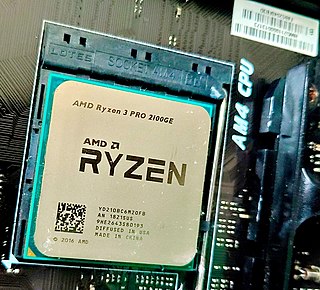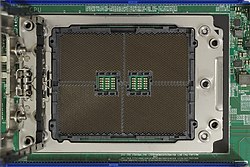
The land grid array (LGA) is a type of surface-mount packaging for integrated circuits (ICs) that is notable for having the pins on the socket — as opposed to pins on the integrated circuit, known as a pin grid array (PGA). An LGA can be electrically connected to a printed circuit board (PCB) either by the use of a socket or by soldering directly to the board.
Zen is a family of computer processor microarchitectures from AMD, first launched in February 2017 with the first generation of its Ryzen CPUs. It is used in Ryzen, Ryzen Threadripper, and Epyc (server).

Zen is the first iteration in the Zen family of computer processor microarchitectures from AMD. It was first used with their Ryzen series of CPUs in February 2017. The first Zen-based preview system was demonstrated at E3 2016, and first substantially detailed at an event hosted a block away from the Intel Developer Forum 2016. The first Zen-based CPUs, codenamed "Summit Ridge", reached the market in early March 2017, Zen-derived Epyc server processors launched in June 2017 and Zen-based APUs arrived in November 2017.

Socket AM4 is a PGA microprocessor socket used by AMD's central processing units (CPUs) built on the Zen and Excavator microarchitectures.

Zen 2 is a computer processor microarchitecture by AMD. It is the successor of AMD's Zen and Zen+ microarchitectures, and is fabricated on the 7 nm MOSFET node from TSMC. The microarchitecture powers the third generation of Ryzen processors, known as Ryzen 3000 for the mainstream desktop chips, Ryzen 4000U/H and Ryzen 5000U for mobile applications, as Threadripper 3000 for high-end desktop systems, and as Ryzen 4000G for accelerated processing units (APUs). The Ryzen 3000 series CPUs were released on 7 July 2019, while the Zen 2-based Epyc server CPUs were released on 7 August 2019. An additional chip, the Ryzen 9 3950X, was released in November 2019.

Ryzen is a brand of multi-core x86-64 microprocessors designed and marketed by Advanced Micro Devices (AMD) for desktop, mobile, server, and embedded platforms based on the Zen microarchitecture. It consists of central processing units (CPUs) marketed for mainstream, enthusiast, server, and workstation segments and accelerated processing units (APUs) marketed for mainstream and entry-level segments and embedded systems applications.
Zen+ is the name for a computer processor microarchitecture by AMD. It is the successor to the first gen Zen microarchitecture, and was first released in April 2018, powering the second generation of Ryzen processors, known as Ryzen 2000 for mainstream desktop systems, Threadripper 2000 for high-end desktop setups and Ryzen 3000G for accelerated processing units (APUs).

Epyc is a brand of multi-core x86-64 microprocessors designed and sold by AMD, based on the company's Zen microarchitecture. Introduced in June 2017, they are specifically targeted for the server and embedded system markets.

Threadripper, or Ryzen Threadripper, is a brand of HEDT and workstation multi-core x86-64 microprocessors designed and marketed by Advanced Micro Devices (AMD), and based on the Zen microarchitecture. It consists of central processing units (CPUs) marketed for mainstream and workstation segments, and as such comes in two line-ups, Threadripper and Threadripper PRO respectively.

Socket TR4, also known as Socket SP3r2, is a zero insertion force land grid array (LGA) CPU socket designed by AMD supporting its first- and second-generation Zen-based Ryzen Threadripper desktop processors, launched on August 10, 2017 for the high-end desktop and workstation platforms. It was succeeded by Socket sTRX4 for the third generation of Ryzen Threadripper processors.
LGA 4094 may refer to four physically identical but electrically incompatible CPU sockets for AMD processors:

Zen 4 is the name for a CPU microarchitecture designed by AMD, released on September 27, 2022. It is the successor to Zen 3 and uses TSMC's N6 process for I/O dies, N5 process for CCDs, and N4 process for APUs. Zen 4 powers Ryzen 7000 performance desktop processors, Ryzen 8000G series mainstream desktop APUs, and Ryzen Threadripper 7000 series HEDT and workstation processors. It is also used in extreme mobile processors, thin & light mobile processors, as well as EPYC 8004/9004 server processors.
Socket sTRX4, also known as Socket SP3r3, is a land grid array (LGA) CPU socket designed by AMD supporting its Zen 2-based third-generation Ryzen Threadripper desktop processors, launched on November 25, 2019 for the high-end desktop and workstation platforms.

Zen 3 is the name for a CPU microarchitecture by AMD, released on November 5, 2020. It is the successor to Zen 2 and uses TSMC's 7 nm process for the chiplets and GlobalFoundries's 14 nm process for the I/O die on the server chips and 12 nm for desktop chips. Zen 3 powers Ryzen 5000 mainstream desktop processors and Epyc server processors. Zen 3 is supported on motherboards with 500 series chipsets; 400 series boards also saw support on select B450 / X470 motherboards with certain BIOSes. Zen 3 is the last microarchitecture before AMD switched to DDR5 memory and new sockets, which are AM5 for the desktop "Ryzen" chips alongside SP5 and SP6 for the EPYC server platform and sTRX8. According to AMD, Zen 3 has a 19% higher instructions per cycle (IPC) on average than Zen 2.

Socket AM5 is a zero insertion force flip-chip land grid array (LGA) CPU socket designed by AMD that is used for AMD Ryzen microprocessors starting with the Zen 4 microarchitecture. AM5 was launched in September 2022 and is the successor to AM4.
Socket sWRX8, also known as Socket SP3r4, is a land grid array (LGA) CPU socket designed by AMD supporting its Ryzen Threadripper Pro 3000 and 5000 series workstation processors, which are based on Zen 2 and Zen 3 platforms, respectively. It was initially launched in July 2020 for OEMs only, with retail availability coming later in March 2021.
Socket SP6 is a zero insertion force land grid array CPU socket designed by AMD supporting its Zen 4c-based Siena Epyc server processors that launched on September 18, 2023. It is designed for server systems targeting infrastructure and edge computing segments.

Socket sTR5 is a land grid array (LGA) CPU socket designed by AMD. It supports the Zen 4-based Ryzen Threadripper 7000 series, which launched in November 2023.













